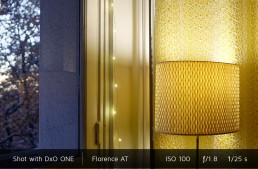Using a polarizing filter Accessories
You can use a polarizing filter to remove the reflection of light on reflective surfaces. This type of filter also slightly increases the density and/or saturates colors.
(Photographer Florence AT)
A polarizing filter is the perfect accessory for landscape photography. It makes the sky bluer, increases contrast in clouds, and makes the colors of the vegetation pop. When photographing a body of water, it eliminates extra reflections, allowing you to see through the surface of a lake or river.
When documenting an urban landscape, it removes the light that bounces off smooth, non-metallic surfaces, such as windows. Such filters are often used in architectural photography, which requires flawless images free of any sort of reflection.
(Photographe Florence AT)
Without polarizing filter
With polarizing filter
Without polarizing filter
With polarizing filter
With the DxO ONE Optical Adapter, you can easily attach this filter to the front of your lens. By slowly turning the filter ring, you’ll be able to immediately see an effect on your smartphone’s screen. You can alter the intensity to suit your needs.
Note that using a polarizing filter reduces the amount of light reaching the lens, which in turn requires a longer exposure time. The DxO ONE’s light-measuring function takes this drop-in light into account and adjusts itself accordingly so that your image is always properly exposed.
You can use this filter with all advanced and automatic shooting modes available on the DxO ONE. It’s most effective when the sun is at its peak or behind you at the end of the day.









 Download page
Download page